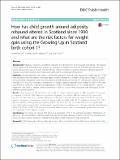Files in this item
How has child growth around adiposity rebound altered in Scotland since 1990 and what are the risk factors for weight gain using the Growing Up in Scotland birth cohort 1?
Item metadata
| dc.contributor.author | Doi, Lawrence | |
| dc.contributor.author | Williams, Andrew James | |
| dc.contributor.author | Frank, John | |
| dc.date.accessioned | 2020-01-20T11:30:10Z | |
| dc.date.available | 2020-01-20T11:30:10Z | |
| dc.date.issued | 2016-10-13 | |
| dc.identifier | 265790016 | |
| dc.identifier | bb90a85a-27fd-4225-a01d-6202c9cce6ab | |
| dc.identifier | 84992152161 | |
| dc.identifier | 27737667 | |
| dc.identifier.citation | Doi , L , Williams , A J & Frank , J 2016 , ' How has child growth around adiposity rebound altered in Scotland since 1990 and what are the risk factors for weight gain using the Growing Up in Scotland birth cohort 1? ' , BMC Public Health , vol. 16 , 1081 . https://doi.org/10.1186/s12889-016-3752-z | en |
| dc.identifier.issn | 1471-2458 | |
| dc.identifier.other | ORCID: /0000-0002-2175-8836/work/67526152 | |
| dc.identifier.uri | https://hdl.handle.net/10023/19312 | |
| dc.description.abstract | Background : Adiposity rebound is considered critical to the development of overweight and obesity. The purpose of this study was to investigate how growth has changed in comparison to the UK 1990 BMI growth reference curves between the ages 4-8 years and identify any marked deviations in growth. We also examined potential maternal and child risk/protective factors associated with the altered growth patterns. Methods : We used data from birth cohort 1 of the Growing Up in Scotland study. Height and weight data (N = 2 857) were available when the children were aged approximately 4 (sweep 4), 6 (sweep 6) and 8 years (sweep 7). For each child, percentile change per month was calculated to identify deviations from the UK 1990 growth patterns. Marked changes (>10 % annual change) in percentiles or weight category between each sweep for each child were considered as reflecting a decreasing (leptogenic), increasing (obesogenic) or no change pattern. Logistic regression was used to explore which maternal or child risk factors were associated with belonging to the different growth patterns. Results : Sixty six percent (66 %) of the cohort did not show marked changes in BMI percentile and growth compared to the UK 1990 reference population. However, the median BMI percentile of this group was around the 70th. The most common deviation in BMI percentile was early decrease (11.5 %). In terms of weight categories, contemporary maternal obesity (odd ratio (OR) =2.89; 95 % confidence interval (CI) 2.09, 3.98) and mother smoking during pregnancy (OR =1.56; 95 % CI 1.13, 2.15) were found to be significantly associated with increased odds of obesogenic growth trajectory relative to no change trajectory. Breastfeeding (OR = 1.18; 95 % CI 0.88, 1.57) was also associated with increased odds of obesogenic growth but this was not significant in the adjusted model. Conclusions : This study has shown that there is a substantial shift in the general population distribution of BMI since 1990. We identified maternal weight status as the strongest obesogenic factor and this is an indication that more innovative obesity preventive strategies should also consider intergenerational approaches. | |
| dc.format.extent | 9 | |
| dc.format.extent | 378402 | |
| dc.language.iso | eng | |
| dc.relation.ispartof | BMC Public Health | en |
| dc.subject | Child | en |
| dc.subject | Overweight | en |
| dc.subject | Obesity | en |
| dc.subject | Adiposity rebound | en |
| dc.subject | Body mass index | en |
| dc.subject | Growth | en |
| dc.subject | Risk factors | en |
| dc.subject | Scotland | en |
| dc.subject | Percentile | en |
| dc.subject | RA0421 Public health. Hygiene. Preventive Medicine | en |
| dc.subject | Public Health, Environmental and Occupational Health | en |
| dc.subject | DAS | en |
| dc.subject | SDG 3 - Good Health and Well-being | en |
| dc.subject.lcc | RA0421 | en |
| dc.title | How has child growth around adiposity rebound altered in Scotland since 1990 and what are the risk factors for weight gain using the Growing Up in Scotland birth cohort 1? | en |
| dc.type | Journal article | en |
| dc.contributor.institution | University of St Andrews. School of Medicine | en |
| dc.identifier.doi | 10.1186/s12889-016-3752-z | |
| dc.description.status | Peer reviewed | en |
This item appears in the following Collection(s)
Items in the St Andrews Research Repository are protected by copyright, with all rights reserved, unless otherwise indicated.

